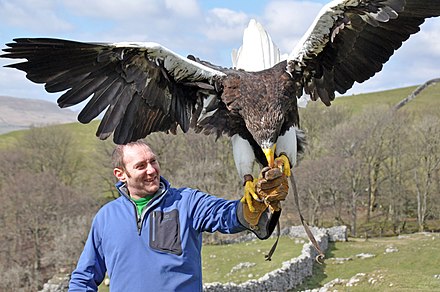Steller’s Sea Eagle (Haliaeetus pelagicus) and Falcon (Falco spp.) are both impressive birds of prey, but they have distinct differences in their physical attributes, hunting techniques, habitats, and conservation status. This article provides a comprehensive comparison of these two fascinating avian species.
Physical Attributes of Steller’s Sea Eagle and Falcon
Steller’s Sea Eagle is one of the largest living eagles, with an average weight of 10.8-20.9 pounds, a body length of 33.5-41.3 inches, and a wingspan of 6.2-8.2 feet. It has a distinctive yellow beak, cere, and legs, with dark brown feathers and white patches on its wings. Its large, powerful talons can exert a force of 400 psi, making it one of the strongest birds of prey.
In contrast, Falcons are smaller and more agile than eagles, with a body length of 9-24 inches and a wingspan of 20-43 inches, depending on the species. They have a slim, streamlined body and long, pointed wings, which enable them to reach high speeds during flight. Falcons have a hooked beak with a “tooth” on each side, which they use to kill their prey by severing the spinal cord.
Hunting Techniques of Steller’s Sea Eagle and Falcon
 Image source: stellers sea eagle
Image source: stellers sea eagle
The Steller’s Sea Eagle primarily feeds on fish and water birds, which it catches by swooping down from a perch or while flying low over the water. It can carry prey weighing up to 10 pounds, thanks to its strong talons and powerful wings.
Falcons, on the other hand, are known for their high-speed dives, or “stooping,” which they use to catch their prey in mid-air. They have excellent eyesight, which enables them to spot prey from great heights and distances. Falcons use their sharp talons to kill their prey, either by piercing their skulls or breaking their necks.
Habitats of Steller’s Sea Eagle and Falcon
The Steller’s Sea Eagle is found in the coastal regions of Russia, Japan, Korea, China, and occasionally Alaska. It prefers rocky cliffs, riverbanks, and forests near bodies of water, where it can find abundant food sources.
Falcons, on the other hand, are found on all continents except Antarctica, in a wide range of habitats, including deserts, grasslands, forests, and coastal areas. Some species, like the Peregrine Falcon, are migratory and travel long distances between their breeding and wintering grounds.
Conservation Status of Steller’s Sea Eagle and Falcon
The Steller’s Sea Eagle is listed as “Vulnerable” by the International Union for Conservation of Nature (IUCN), due to habitat loss, pollution, and overfishing. Conservation efforts, such as captive breeding programs and habitat restoration, are underway to protect this species.
The conservation status of falcons varies by species, with some, like the Peregrine Falcon, recovering from the brink of extinction thanks to conservation efforts. However, other species, like the Mauritius Kestrel, are still critically endangered, due to habitat loss, pollution, and other threats.
In conclusion, while both the Steller’s Sea Eagle and Falcon are impressive birds of prey, they have distinct differences in their physical attributes, hunting techniques, habitats, and conservation status. Understanding these differences can help us appreciate the diversity and complexity of the avian world and inspire us to take action to protect these magnificent creatures and their habitats.
References:
– WorldAtlas. (2022-04-23). The World’s Largest Eagles. Retrieved from https://www.worldatlas.com/animals/the-world-s-largest-eagles.html
– National Geographic. (n.d.). Falcon. Retrieved from https://www.nationalgeographic.com/animals/birds/f/falcon/.

